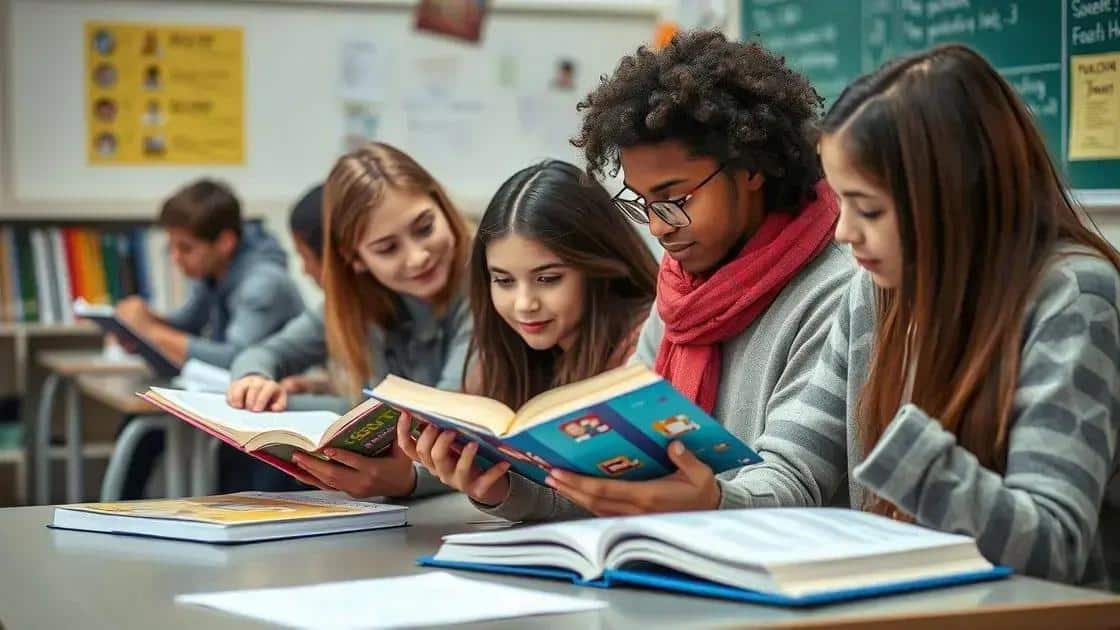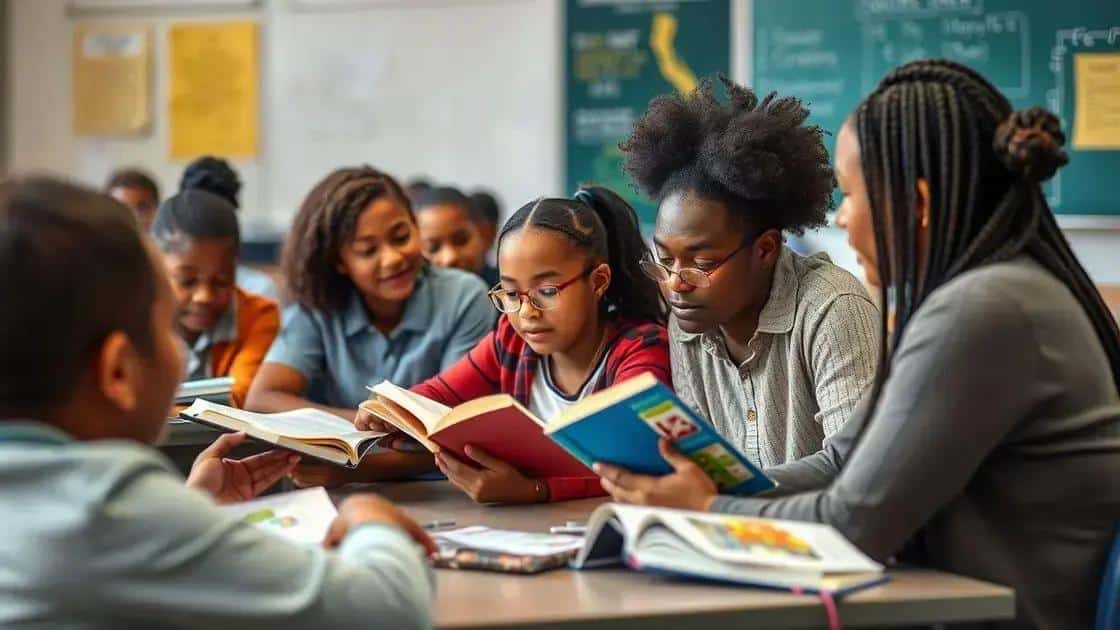Choice textbook policy updates: what you need to know

Choice textbook policy updates focus on enhancing accessibility, affordability, and diversity in educational resources, utilizing digital and Open Educational Resources (OER) to create a more inclusive and effective learning environment.
Choice textbook policy updates are changing the landscape of education resources. How do these changes influence curriculum decisions and what should educators consider moving forward? Let’s dive into the details.
Understanding choice textbook policy updates
Understanding choice textbook policy updates is essential for educators and students alike. These updates can bring significant changes to how textbooks are selected and utilized in classrooms.
The new policies aim to enhance accessibility and affordability for students. By staying informed about these changes, educators can make better decisions when it comes to selecting materials that benefit their students.
Key Aspects of Updated Policies
It’s important to know what these new policies entail. Here are some essential elements:
- Increased Accessibility: New guidelines focus on ensuring students have access to necessary learning resources.
- Affordability Initiatives: Policies are being established to reduce the financial burden on students regarding textbook purchases.
- Flexible Options: Educators now have more choices in selecting materials that suit their curriculum needs.
Educators should be aware of the processes involved in implementing these policies. Understanding how to navigate the new selection procedures can help streamline the transition for both teachers and students.
Impacts on Curriculum Delivery
These updates significantly affect how courses are taught. With more accessible resources, students can engage more deeply with the material. This enhanced engagement can improve their overall learning experience.
Additionally, the use of varied resources encourages different learning styles. For instance, adopting digital materials can cater to tech-savvy students while also providing traditional textbooks for those who prefer classic formats.
Finally, staying informed about ongoing updates ensures that educators can adjust their teaching strategies accordingly. This adaptability can lead to a more effective educational environment for all.
Key changes in textbook selection procedures
Key changes in textbook selection procedures play a crucial role in shaping the learning environment. These updates simplify the way educators choose materials, making the process more efficient and transparent.
One major change is the introduction of standardized criteria for evaluating textbooks. This ensures that all materials meet the same high standards. It empowers educators by providing clear guidelines on what to look for in a textbook.
Standardized Evaluation Criteria
The standardized evaluation criteria focus on several essential areas:
- Content Accuracy: Textbooks must provide reliable and factual information.
- Inclusivity: Materials should reflect diverse perspectives and cultures.
- Alignment with Standards: Textbooks must align with state and national educational standards.
These criteria help teachers select textbooks that are not only informative but also engaging for students. This results in a richer learning experience.
Streamlined Approval Processes
Another significant update is the streamlining of approval processes for new materials. With fewer bureaucratic hurdles, educators can quickly adopt new resources.
This flexibility allows schools to respond actively to changes in curriculum needs or student demographics. As a result, educators can ensure their selections are relevant and up to date.
Furthermore, technology plays an important role in these changes. Online platforms make it easier for teachers to access reviews and recommendations for textbooks. By utilizing digital tools, educators can make informed choices more efficiently.
Impacts on students and educators

The impacts on students and educators due to new policies on textbook selection are significant. These changes directly affect how learning materials are chosen and accessed, shaping the educational experience.
For students, improved access to quality textbooks means better learning opportunities. When textbooks align with their needs, students are more engaged in their education. They can explore subjects deeply, and the resources available can cater to various learning styles.
Benefits for Students
Here are some key benefits that students experience:
- Access to Current Information: Updated policies ensure that students have the latest resources at their fingertips.
- Diverse Materials: A wider selection fosters diverse perspectives and inclusiveness.
- Enhanced Learning Engagement: When students interact with relevant materials, their motivation and participation increase.
Educators also gain from these new changes. With clearer guidelines and streamlined processes, teachers can spend more time teaching rather than navigating complex approval systems. They can confidently select textbooks that complement their curriculum.
Benefits for Educators
Some key advantages for educators include:
- Better Resource Selection: Easier access to reviews and evaluations helps in making informed choices.
- Time Savings: Reducing bureaucratic delays allows teachers to adopt materials swiftly.
- Improved Student Outcomes: Selecting the right textbooks leads to enhanced student performance and satisfaction.
In conclusion, both students and educators benefit from a more efficient textbook selection process. The overall educational environment becomes more dynamic, fostering better learning experiences and outcomes for everyone involved.
Navigating the implementation of new policies
Navigating the implementation of new policies on textbook selection can seem daunting, but understanding the process makes it easier. Educators play a key role in adapting to these changes, ensuring textbooks are effectively integrated into the curriculum.
The first step in this journey requires familiarity with the new guidelines. Schools often provide training sessions or resources to help teachers understand the updates. This supportive approach can greatly ease the transition, allowing teachers to feel confident in their decisions.
Steps for Effective Implementation
Here are crucial steps educators should consider when implementing new policies:
- Attend Training Sessions: Professional development workshops can clarify policy changes.
- Collaborate with Peers: Working with other educators fosters idea-sharing and collective problem-solving.
- Evaluate Textbook Options: Utilize the new criteria to select textbooks that best suit your curriculum.
Additionally, maintaining open communication with administration is vital. Feedback from educators can help refine the policies over time, ensuring they meet the needs of both students and teachers. Educators should voice their experiences and suggest improvements based on classroom realities.
Utilizing Resources for Success
Using available resources, such as online platforms and community forums, can further support teachers in navigating the new policies. Many districts offer digital tools that provide access to textbook reviews and instructional materials. Engaging with these resources empowers teachers to make informed choices.
Using data from student performance can also guide textbook selection strategies. This data helps educators determine which materials resonate best with students, enhancing overall learning outcomes. By focusing on evidence-based strategies, teachers can optimize their textbook selections.
Future trends in textbook choices
Future trends in textbook choices are poised to reshape the educational landscape. As technology evolves, so do the resources available to educators and students. Understanding these trends can help schools stay ahead of the curve.
One significant trend is the shift towards more digital resources. E-books and online textbooks are becoming increasingly popular, allowing for easy access and often lower costs. These formats enable students to interact with material in innovative ways, such as through embedded videos and interactive quizzes.
Increasing Use of Open Educational Resources
The rise of Open Educational Resources (OER) is another notable trend. OER are freely accessible and openly licensed materials that educators can adapt and share. This approach promotes collaboration among teachers and provides diverse learning materials for students.
- Cost Savings: OER reduces expenses for students and schools.
- Customization: Educators can tailor resources to meet specific curriculum needs.
- Collaboration: Teachers can share and improve resources collectively.
Moreover, the move toward personalized learning is changing how textbooks are selected. Educators can choose materials that cater to different learning styles, ensuring every student has access to the resources they need to succeed. This strategy promotes engagement and deeper understanding of the subject matter.
Focus on Inclusivity and Diversity
Another trend is the increasing focus on inclusivity and diversity in educational materials. More publishers are creating textbooks that represent a variety of cultures, perspectives, and experiences. This is essential for fostering an inclusive learning environment where all students feel seen and valued.
As schools and educators look to the future, considering these trends in textbook choices is vital. By embracing technology, OER, personalization, and inclusivity, education can become more effective and responsive to the needs of students.
FAQ – Frequently Asked Questions about Textbook Policy Updates
What are the main goals of the updated textbook policies?
The updated textbook policies aim to enhance accessibility, affordability, and diversity in educational resources for students and educators.
How do digital resources improve textbook selection?
Digital resources provide easier access, lower costs, and opportunities for interactive learning, making them attractive options for schools.
What are Open Educational Resources (OER)?
OER are freely available teaching materials that can be adapted and shared, promoting collaboration among educators and reducing costs for students.
Why is inclusivity important in educational materials?
Inclusivity in educational materials ensures that diverse perspectives are represented, creating a more engaging and relevant learning environment for all students.





